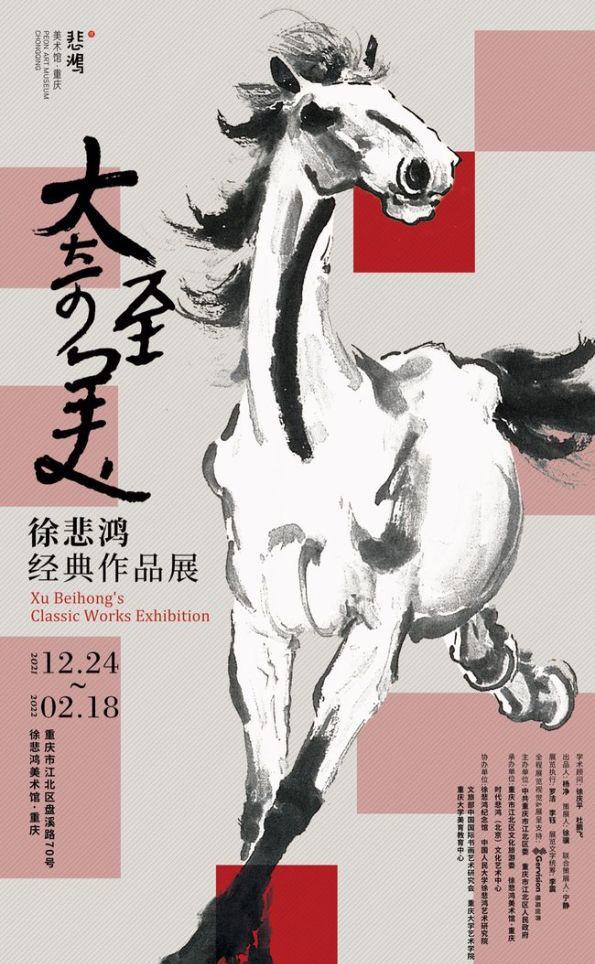Xu Beihong is an outstanding artist and collector in China, the father of Chinese aesthetic education. He has made outstanding achievements in the three fields of Chinese painting, oil painting and drawing, and has established a mature system of modern Chinese aesthetic education. It has a great influence on the process of Chinese art entering modernity, and has been praised by international critics as the "father of modern Chinese painting".

This time, Chongqing Xu Beihong Art Museum exhibited for the first time the well-known "Qun Ben", "Herd Cattle" and the most representative Xu Beihong oil paintings in the history of Chinese oil painting, in the Chinese auction market in the past decade, Xu Beihong's works have created the auction price of that year.
Xu Beihong advocates "the creation of the heart" and "the appeal of the true zai", advocating the creation of an artistic image of the world-shattering and weeping ghost god through the combination of the painter's soul and nature. He put forward the theory of "the best of the ancient law is kept, the one who is desperation is followed, the poor is changed, the insufficient is increased, and the Western painting can be absorbed" the theory of writing, which re-established the excellent tradition of Chinese painters' legal creation.
Xu Grief, self-portrait, drawing, 27.5cmx41cm, 1925
Xu Beihong, Galloping Horse, Chinese Painting 95cmx68cm, 1939
During the Period of the War of Resistance Against Japanese Aggression, Xu Beihong not only created many works of historical themes with huge scales and far-reaching meanings to awaken the people and inspire fighting spirit; he also placed this national sentiment in the way of entrusting things and words to all living beings in his pen, becoming another vivid symbol of the national spirit of that era and even the present. At the most difficult moment of the War of Resistance Against Japan, whether it is a war horse that "mourns the people and fights, and stands up to the heavens", or a galloping horse; whether it is an awakened male lion standing up, or a mighty and majestic group of lions converging on the top of Fuji Mountain; or an eagle looking at the eagle, the wind and rain and the rooster singing, the magnificent memories... Xu Beihong has given them heroic courage and strength, urging people to forge ahead, showing the fearlessness of Chinese people in the face of hardships and hardships, and moving forward.
Xu Beihong, Guilin Landscape, Oil on canvas, 56cmx74cm, 1936
His characters, whether sages and philosophers, or boats and peasant women, are all physical and divine, and they are ready to come out. He is good at capturing the most beautiful moments of the characters, conveying their psychological activities and touching spirits: the warriors who were born and died for the country, the Jiufanggao who was born and died for the Bole Soma, the Lao Tzu who "does not know the end"... All flash the light of bravery and wisdom of the Chinese nation.
The natural scenery painted by Xu Beihong, even if it is a bamboo and a stone, a cat and a bird, all want to exhaust the wonders of creation, conveying a unique artistic conception and timeless poetry. Pine cypresses that have snaked through the wind and frost for a hundred years, chickens that sing in the wind and rain, finches that spread their wings in the wind and wind, and male lions who are wounded and whose eyes are shining without losing dignity, are all full of vitality and interest, giving people a sense of beauty and enlightenment.
Xu Beihong, QunBen (壬午大夏, Chinese painting, 96cmx183.2cm, 1942
Xu Beihong, Guo Yan, Chinese Painting, 107cmx62cm, 1943
Xu Beihong, Poor Woman, 102cmx62cm, 1937
Xu Beihong, Herd of Cattle, Chinese Painting, 95cmx178cm, 1931
Xu Beihong's achievements in art are inseparable from his progressive ideas, and his entry into Chinese painting from the west is not only beneficial to the excellent tradition of Chinese painting, but also to the scientific techniques of the West; he reformed Chinese painting and established an art education system suitable for China's national conditions, which has a huge and far-reaching impact on the development of China's modern painting world.
In addition to the representative Chinese paintings and oil paintings "Self-Portrait of Xu Beihong" and "Portrait of Madame Xu" mentioned earlier, there are also influential works such as "Poor Woman" and "National Martyrdom" created in the Chongqing period, which are definitely a rare cultural feast for Chongqing citizens and art lovers.
Exhibition theme: "Great Wonder to Beauty" Exhibition of Xu Beihong's Classic Works
Exhibition time: December 24, 2021 - February 18, 2022
Venue: Xu Beihong Art Museum, Chongqing
(Shijia Garden, No. 70 Panxi Road, Jiangbei District, Chongqing)
Academic advisors: Xu Qingping, Du Pengfei
Producer: Yang Jing
Curator: Xu Ji
Co-Curator: Serenity
Exhibition Executive: Luo Jie, Li Yu
Exhibition text coordinator: Li Zhen
Exhibition Visual & Exhibition Support: Pattern Creation Culture Gervision
Organizers: CPC Chongqing Jiangbei District Committee, Chongqing Jiangbei District People's Government
Organizers: Chongqing Jiangbei District Cultural and Tourism Commission, Xu Beihong Art Museum Chongqing, Times Beihong (Beijing) Culture and Art Center
Co-organizers: Xu Beihong Memorial Hall, Xu Beihong Art Research Institute of Chinese University, China International Calligraphy and Painting Art Research Association of the Ministry of Culture and Tourism, School of Art of Chongqing University, Aesthetic Education Center of Chongqing University